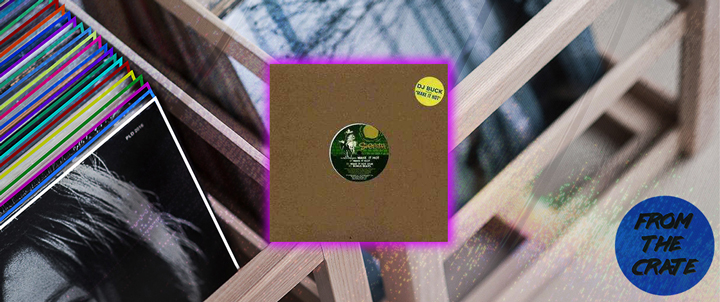DJ Buck “Make It Hot”
The birth of our underground brand Factory 93 not only brought on an adrenaline rush reminiscent of the renegade warehouse era of raving—on which Insomniac was founded—but it also had us thinking back to all the people, places and parties that made this whole operation possible. And with that came a burning desire to crack open our collection and dust off the classic records we couldn’t live without. Through our From the Crates series, we’ll be breaking out both seminal and obscure cuts alike, imparting some knowledge in the process.

It’s not the most groundbreaking track around, nor is it the most iconic. It’s not necessarily the tune that burrows its way into your skull and takes up residence there, and it rarely finds itself on a list of acknowledged club classics. Nonetheless, DJ Buck’s “Make It Hot,” released on Siesta Music in 2001, is a glorious example of the house music magic that can happen when a mere handful of ingredients are blended just so, resulting in a tune brimming with the kind of slightly offbeat flavor that’s hard not to love.
DJ Buck was born with the name Kuyumptiwa Kopavi Grok Tinkelman (no wonder he opted for a more manageable alias) and moved to San Francisco from New York City as a child. By 1994, he was firmly established as a DJ and producer within the West Coast house scene, a geographical hotbed centered in the Bay Area but stretching from Vancouver to San Diego. (Buck himself relocated to L.A. in 2001.)
The West Coast sound of the ’90s and early ’00s certainly wasn’t monolithic, but it could be loosely defined as an amalgam of the acidic and discoid stylings favored by English immigrants, like the Wicked Crew, the jacking Chicago style that was the forte of Windy City transplant Mark Farina, and whatever inherent love-and-psychedelia vibe that hadn’t faded from the city since the original Summer of Love, personified by the likes of the Hardkiss clan and Dubtribe Sound System. (Other key players include the Bay Area’s DJ Rasoul, Chris Lum and Jay-J Hernandez; L.A.’s Eddie Amador, the man behind the strutting “House Music”; San Diego’s Hipp-E and his H-Foundation partner Halo; and honorary West Coast–style house producers, such as New York’s Joeski and Onionz and the UK’s Tony Hewitt.) Sometimes, the brew manifested itself as forceful tribal tech; at other times, it could be laid-back and groovy. The common denominator was a slightly skewed, tripped-out funkiness that was hard to miss and even harder to resist. “Make It Hot” falls firmly in that tradition.
“The fun comes via a series of vocal sample snippets, including a party-starting emcee at the track’s beginning, the occasional “whoop,” a series of hype-man-style “come on, come on” bits, and most notably, a brief morsel of Missy Elliott, informing us that “before I go, I just wanna make you hot.”
The main mix of “Make It Hot” is a simple but effective track, basically a conga- and woodblock-fueled groove, along with some whooshes and a simple two-note bassline that doesn’t bother to kick in until the two-minute mark. The fun comes via a series of vocal sample snippets, including a party-starting emcee at the track’s beginning, the occasional “whoop,” a series of hype-man-style “come on, come on” bits, and most notably, a brief morsel of Missy Elliott, informing us that “before I go, I just wanna make you hot.” Some DJs—those who figured they needed a fuller, more tribal sound to fill their rooms—opted for this mix, but most discerning spinners opted for the wondrous dub version.
The dub adds a perky little synth riff and a touch of spectral piano here and there, pushing the congas ever-so-gently into the background. It’s not a major revamp of the original, but through some form of psychoacoustic hocus-pocus, its emphasis is noticeably shifted toward the “make you hot” sample. It’s hard to pinpoint precisely how Buck achieved this—it likely was a happy accident—but boy, does it ever work. This writer was lucky enough to experience the then-new tune played in seedy 100-capacity basement parties and in massive superclubs (Twilo, to be precise), and the sample, occurring on only a couple of occasions over the song’s six and a half minutes, was enough to send the crowd into a wide-eyed frenzy. In a denser track, it probably wouldn’t work, but within the cheerful minimalism of “Make It Hot,” it’s all that’s needed. It’s a prime example of how the simplest twist can transform a pretty good track into a great one.
“Make It Hot” wasn’t DJ Buck’s first great track. That would be his debut, 1995’s “The Bells of San Francisco,” released on NYC’s mighty Strictly Rhythm. Nor was it his last. That honor goes to the final track to come out under the DJ Buck moniker, a brilliant 2007 cover of Bobby Konders’ “Nervous Acid,” appearing on Rong Music sublabel Tu Rong. As far as what Buck’s been up to since then… well, his website looks like it hasn’t been updated since his glory days, and internet sleuthing won’t get you very far, except to let you know there are a bunch of other DJ Bucks out there. But none of those Bucks ever put together such an oddly endearing track as “Make It Hot,” and it’s safe to say they never will.






